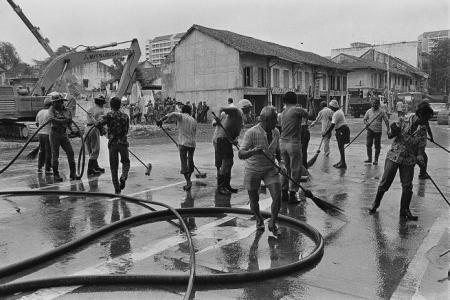Hotel New World: 'I always imagined he would come out'
She was at work when news of the building collapse reached her.
In her first interview since the Hotel New World disaster in 1986, Madam Shirley Chan, 66, recounted: "It was about midday that Saturday when a colleague told us the news. I knew my husband was at work.
"But I was still feeling very positive, even when my own bank manager took me to the scene."
She cannot remember the full details of the chain of events, but recalled how "all I saw were just sand and slabs of concrete".
The six-storey building at the junction of Serangoon Road and Owen Road - which housed a 67-room hotel, a branch office of the Industrial & Commercial Bank (ICB) on the first storey and a carpark in the basement - collapsed on March 15 at about 11.25am.

The collapse, which lasted less than a minute, did not leave a single wall or column standing and reduced the entire building to rubble.
Rescue operations ended four days later with 17 survivors pulled from the rubble. The last survivor rescued, Madam Chua Kim Choo, 46, had spent 83 hours in total darkness.
On March 21, the final 12 bodies were uncovered as workers cleared away the remaining rubble and removed more than 30 cars from the bottom of the heap. This brought the final death toll to 33.
Madam Chan, then 36, was working as a secretary in the corporate banking department at Hong Kong and Shanghai Bank.
Her husband, Mr Albert Kan, 38, was a manager at ICB.
In the days that followed the tragedy, she was supported by her family members as they kept round-the-clock vigil.
She said: "In my imagination, it had always been... he'd come out and tell us what happened."
Their sons were then 13 and 11.
Then on the third day, she recalled, "someone called Albert" was pulled out alive.
It turned out to be bank officer Albert Sim, then 36, who had been buried in the rubble for more than two days.
The final, heartbreaking call came on the seventh day asking her to go down and identify her husband's body.
"The first thing my brother did was to tell my other sisters not to let me see the body," she added.

Years later, she asked that sister who was crying in a corner after the identification, what her late husband had looked like.
"She told me, there were maggots crawling out of holes all over," said Madam Chan.
"I suppose it was good for me to remember his nice face."
But the tragedy took a toll on her elder son, she admitted.
"It was traumatic for my elder boy because on the day his father left, there was an exchange of words."
Mr Kan had refused to allow the St Andrew's Secondary School student to go out to play rugby as he had not tidied up his room.
"So having your father scold you and that being the last memory you had wasn't very nice," she said quietly.
It got more traumatic at the wake when the closed coffin arrived.
Madam Chan lost her composure, her tears flowing freely. It was something she had not spoken about, not even to her siblings.
She said: "My son asked, 'Why is the coffin not open? I want to see my father' but the undertaker said no.
"They were nice about it, they just said the body smelled."
Around the time of the tragedy, the Kan family were planning to move into their new home, a three-split-level landed property at Coronation Road.
They never did. Madam Chan said she sold the house and by the end of 1987, she left Singapore to join her sisters, who were living in Perth, Australia.
"Even in Perth, my elder son was such an angry boy. Whatever as a mother, you said to do, he would not. I was so frustrated, one day I told him, 'Son, please don't fight with me. I know you lost your father and you are upset'.
"Then he said, 'My father never loved me'. The next thing (to do) was to get him a counsellor."
After awhile, her son stopped talking about his father's death.
Madam Chan, who was in Singapore late last month for her mother's funeral, said: "It was all a shock."
In the final report by a commission of inquiry that was released on Feb 16, 1987, the panel concluded that the collapse was due to the shoddy structural design of the building. The problem was further exacerbated by new installations on the roof, which caused the appearance of persistent cracks in columns, walls and floors weeks before the collapse.

Blessings

Pope John Paul II kissed the Changi Airport tarmac during a five-hour stopover on Nov 20. He was on an Asia-Pacific tour that included visits to Bangladesh and Australia.
Get The New Paper on your phone with the free TNP app. Download from the Apple App Store or Google Play Store now





